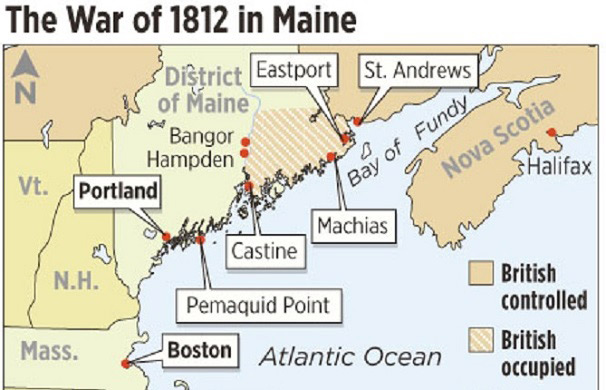When war broke out, most Americans living along the porous borderlands region of Eastern Maine saw no reason to curtail their enduring cultural, social, and trading ties with Canadians.
The most lucrative business which is now carried on.

Portland Press Herald.
The War of 1812 featured many odd twists. At the same time the American government met to declare war on Britain in June 1812, New Englanders publicly resolved to keep commercial ties open with the British in Canada through illicit trade. Indeed, citizens of Eastport, in the District of Maine, reassured the people of nearby St. John, New Brunswick that they had “agreed to preserve a good understanding” with their Canadian friends, and “to discountenance all depredations on the Property of each other.”
Eastern Maine and the Canadian Maritime region constituted an international crossroads. Cultural, economic, and marital ties connected inhabitants on both sides of the borderlands region. From their perspective, there was no reason for an obscure and needless conflict to disrupt the natural links among the inhabitants.
And there was money to be made. After years of economic hardship brought on by Jefferson’s Embargo, merchants and other local shipping interests had little difficulty ignoring their distant national government’s calls for more self-sacrifice in the name of patriotism.
Because of its proximity to adjacent Canadian ports, Eastport became a major hub for illegal smuggling throughout the war. Typically, flotillas of open rowboats laden with goods such as flour, pork, and salt would set out under the cover of darkness or dense fog for nearby Canadian ports. There, they discharged their cargos, and often returned with highly prized British textiles and hardware. Larger vessels often sailed under the flags of neutral European powers such as Sweden.
The Madison Administration tried to disrupt illegal trade at Eastport by sending in troops. But it was a fool’s errand, as the soldiers repeatedly found themselves outwitted and outmaneuvered by Eastport’s community-wide network of informants and skilled seamen.
Along the borderlands regions, from New York to Vermont and eastern Maine, the pervasiveness of smuggling highlighted one more form of domestic resistance in the conflict-ridden War of 1812.
Last updated: August 23, 2017
